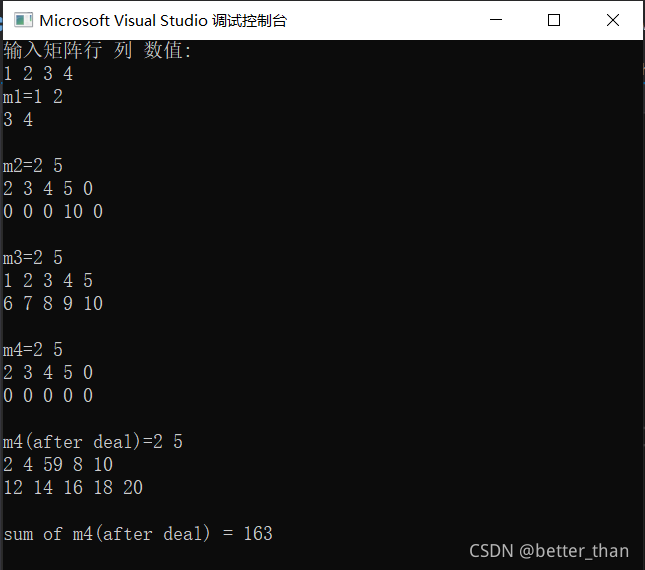基本内容
本文用c++实现矩阵基本操作
一、构造函数
CMatrix(): 不带参数的构造函数;
CMatrix(int nRow, int nCol, double *pData=NULL) : 带行、列及数据指针等参数的构造函数,并且参数带默认值;
CMatrix(const char * strPath): 带文件路径参数的构造函数;
CMatrix(const CMatrix& m): 拷贝构造函数
此外会用列表初始化成员变量:CMatrix(): m_nRow(0), m_nCol(0), m_pData(NULL);
bool Create(int nRow, int nCol, double *pData=NULL): 先删除原有空间,根据传入行列创建空间,如果pData不为空要将pData的内容拷贝到m_pData中。
二、析构函数
~CMatrix(): 调用Release();
Release(): 将内存释放,并将行列设置为0;
三、运算符重载
算术运算符重载:+, -, +=, -=
关系运算符重载:>, <, ==
下标操作符:[], ()
强制类型转换: double
赋值运算符:=,尤其注意当m1=m1特殊情况的处理
四、友元函数
输入和输出运输符:<<, >>
五、作业提交方式
写完请发表博客,上传博客链接
代码实现
该矩阵的声明CMatrix.h
#ifndef CMATRIX_H
#define CMATRIX_H
#include <iostream>
using namespace std;
class CMatrix
{
public:
CMatrix(); //构造函数
CMatrix(int nRow, int nCol, double* pData = NULL);
CMatrix(const CMatrix& m);
CMatrix(const char* strPath);
~CMatrix(); //析构函数
bool Create(int nRow, int nCol, double* pData = NULL); //初始化
void Set(int nRow, int nCol, double dVale);
void Release(); //释放内存
// 一序列运算符重载
friend istream& operator>>(istream& is, CMatrix& m); //声明友元函数,使得非成员函数也可以访问该类的私有成员
friend ostream& operator<<(ostream& os, const CMatrix& m);
CMatrix& operator=(const CMatrix& m);
CMatrix& operator+=(const CMatrix& m);
// CMatrix& operator+(const CMatrix& m);
// CMatrix operator+(const CMatrix& m1,const CMatrix& m2);
double& operator[](int nIndex);
double& operator()(int nRow, int nCol);
bool operator ==(const CMatrix& m);
bool operator !=(const CMatrix& m);
//重载强制类型转换
operator double();
private:
// 矩阵的行数,列数,数值
int m_nRow;
int m_nCol;
double* m_pData;
};
CMatrix operator+(const CMatrix& m1, const CMatrix& m2); // 双目运算符重载
inline void CMatrix::Set(int nRow, int nCol, double dVal)
{
m_pData[nRow * m_nCol + nCol] = dVal;
}
#endif
矩阵实现 CMatrix.cpp
#include "CMatrix.h"
#include <fstream>
#include <assert.h>
CMatrix::CMatrix() : m_nRow(0), m_nCol(0), m_pData(0) // c++里初始化方式相当于括号内
{
/*m_nRow = 0;
m_nCol = 0;
m_pData = 0;*/
}
CMatrix::CMatrix(int nRow, int nCol, double* pData) : m_pData(0)
{
Create(nRow, nCol, pData);
}
CMatrix::CMatrix(const CMatrix& m) : m_pData(0)
{
*this = m; // this指向当前类
}
CMatrix::CMatrix(const char* strPath)
{
m_pData = 0;
m_nRow = m_nCol = 0;
ifstream cin(strPath); // 输入文件流
cin >> *this;
}
CMatrix::~CMatrix()
{
Release();
}
bool CMatrix::Create(int nRow, int nCol, double* pData)
{
Release();
m_pData = new double[nRow * nCol];
m_nRow = nRow;
m_nCol = nCol;
if (pData)
{
memcpy(m_pData, pData, nRow * nCol * sizeof(double));
return true;
}
return false;
}
void CMatrix::Release()
{
if (m_pData)
{
delete[]m_pData;
m_pData = NULL;
}
m_nRow = m_nCol = 0;
}
CMatrix& CMatrix::operator=(const CMatrix& m)
{
if (this != &m) { // 防止将自己赋值给自己时出现内存被释放掉的情况
Create(m.m_nRow, m.m_nCol, m.m_pData);
}
return *this;
}
CMatrix& CMatrix::operator+=(const CMatrix& m)
{
assert(m_nRow == m.m_nRow && m_nCol == m.m_nCol);
for (int i = 0; i < m_nRow * m_nCol; i++)
{
m_pData[i] += m.m_pData[i];
}
return *this;
}
//CMatrix& CMatrix::operator+(const CMatrix& m)
//{
// assert(m_nRow==m.m_nRow && m_nCol==m.m_nCol);
// for(int i=0;i<m_nRow*m_nCol;i++)
// {
// m_pData[i]+=m.m_pData[i];
// }
// return *this;
//}
//CMatrix CMatrix::operator+(const CMatrix& m1,const CMatrix& m2)
//{
// CMatrix m3(m1);
// m3+=m2;
// return m3;
//}
CMatrix operator+(const CMatrix& m1, const CMatrix& m2)
{
CMatrix m3(m1);
m3 += m2;
return m3;
}
double& CMatrix::operator[](int nIndex)
{
assert(nIndex < m_nRow * m_nCol);
return m_pData[nIndex];
}
double& CMatrix::operator()(int nRow, int nCol)
{
assert(nRow * m_nCol + nCol < m_nRow * m_nCol);
return m_pData[nRow * m_nCol + nCol];
}
bool CMatrix::operator == (const CMatrix& m)
{
if (!(m_nRow == m.m_nRow && m_nCol == m.m_nCol))
{
return false;
}
for (int i = 0; i < m_nRow * m_nCol; i++)
{
if (m_pData[i] != m.m_pData[i])
{
return false;
}
}
return true;
}
bool CMatrix::operator !=(const CMatrix& m)
{
return !((*this) == m);
}
CMatrix::operator double()
{
double dS = 0;
for (int i = 0; i < m_nRow * m_nCol; i++)
{
dS += m_pData[i];
}
return dS;
}
// 对CMatrix的cin,cout
istream& operator>>(istream& is, CMatrix& m)
{
is >> m.m_nRow >> m.m_nCol;
m.Create(m.m_nRow, m.m_nCol);
for (int i = 0; i < m.m_nRow * m.m_nCol; i++)
{
is >> m.m_pData[i];
}
return is;
}
ostream& operator<<(ostream& os, const CMatrix& m)
{
os << m.m_nRow << " " << m.m_nCol << endl;
double* pData = m.m_pData;
for (int i = 0; i < m.m_nRow; i++)
{
for (int j = 0; j < m.m_nCol; j++)
{
os << *pData++ << " ";
}
os << endl;
}
return os;
}
主函数矩阵的简单操作示例
#include <iostream>
/* run this program using the console pauser or add your own getch, system("pause")*/
#include <stdio.h>
#include "CMatrix.h"
#include <direct.h>
using namespace std;
int main(int argc, char** argv) {
double pData[10] = { 2,3,4,5 };
//cout<<"路径" << getcwd(NULL, 0)<<endl;
CMatrix m1, m2(2, 5, pData), m3("1.txt"), m4(m2);
cout << "输入矩阵行 列 数值:" << endl;
cin >> m1;
m2.Set(1, 3, 10);
cout <<"m1="<< m1 <<"\nm2="<< m2 <<"\nm3="<< m3 <<"\nm4="<< m4;
m4 = m3;
m4[2] = m4 + 1;
if (m4 == m3)
{
cout << "Error !" << endl;
}
m4 += m3;
cout << "\nm4(after deal)=" << m4 << endl;
cout << "sum of m4(after deal) = " << (double)m4 << endl;
return 0;
}
运行演示

reference
代码大多为老师课上代码,因为仅涉及c++的基本操作,且觉得没多少可以增加的,于是对代码加了部分觉得比较有用的注释。